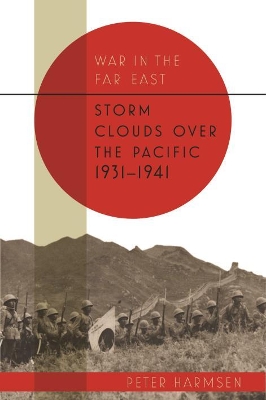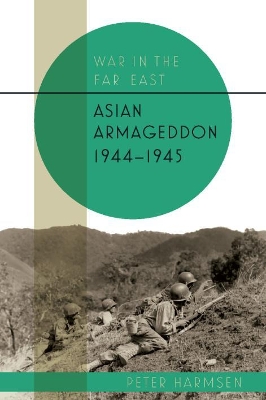War in the Far East
2 primary works • 4 total works
Book 1
Book 2
In early 1942, the Japanese Army and Navy were advancing on all fronts, humiliating their US, British and Dutch foes throughout the Asia Pacific. In a matter of just months, the soldiers and sailors of the Rising Sun conquered an area even bigger than Hitler's empire at its largest extent. They seemed invincible. Hawaiians and Australians were fearing a future under Hirohito. For half of mankind, fate was hanging in the balance.
Fast forward to the end of 1943, and the tables had been turned entirely. A reinvigorated American-led military machine had kicked into gear, and the Japanese were fighting a defensive battle along a frontline that crossed thousands of miles of land and ocean. Japan Runs Wild, 1942-1943 by acclaimed author Peter Harmsen details the astonishing transformation that took place in that period, setting the Allies on a path to final victory against Japan.
This second installment in the trilogy, War in the Far East, picks up the story where first volume Storm Clouds over the Pacific, 1931-1941 left off. The trilogy will give a comprehensive view of World War II in the Asia Pacific, with due emphasis on the central Japanese-American struggle, but also examining the role of the other nations engulfed in the vast showdown: British, Australians, Soviets, Filipinos, Indians and Koreans. Above all, the central importance of China is highlighted in a way that no previous general history of the war against Japan has achieved.
Fast forward to the end of 1943, and the tables had been turned entirely. A reinvigorated American-led military machine had kicked into gear, and the Japanese were fighting a defensive battle along a frontline that crossed thousands of miles of land and ocean. Japan Runs Wild, 1942-1943 by acclaimed author Peter Harmsen details the astonishing transformation that took place in that period, setting the Allies on a path to final victory against Japan.
This second installment in the trilogy, War in the Far East, picks up the story where first volume Storm Clouds over the Pacific, 1931-1941 left off. The trilogy will give a comprehensive view of World War II in the Asia Pacific, with due emphasis on the central Japanese-American struggle, but also examining the role of the other nations engulfed in the vast showdown: British, Australians, Soviets, Filipinos, Indians and Koreans. Above all, the central importance of China is highlighted in a way that no previous general history of the war against Japan has achieved.
War in the Asia Pacific is a trilogy of books comprising a general history of the war against Japan; unlike other histories it expands the narrative beginning long before Pearl Harbor and encompasses a much wider group of actors to produce the most complete narrative yet written and the first truly international treatment of the epic conflict. Peter Harmsen uses his renowned ability to weave together complex events into an entertaining and revealing narrative, including facets of the war that may be unknown to many readers of WWII history, such as the war in Subarctic conditions on the Aleutians, or the mass starvations that cost the lives of millions in China, Indochina, and India, and offering a range of perspectives to reflect what war was like both at the top and at the bottom, from the Oval Office to the blistering sands of Peleliu.
Storm Clouds over the Pacific begins the story long before Pearl Harbor, showing how the war can only be understood if ancient hatreds and long-standing geopolitics are taken into account. Peter Harmsen demonstrates how Japan and China’s ancient enmity grew in the late nineteenth and early twentieth centuries leading to increased tensions in the 1930s which exploded into conflict in 1937. The battles of Shanghai and Nanjing were followed by the battle of Taierzhuang in 1938, China’s only major victory. A war of attrition continued up to 1941, the year when Japan made the momentous decision for all-out war; the infamous attack on Pearl Harbor catapulted the United States into the war, and the Japanese also overran British and Dutch territories throughout the western Pacific.
Storm Clouds over the Pacific begins the story long before Pearl Harbor, showing how the war can only be understood if ancient hatreds and long-standing geopolitics are taken into account. Peter Harmsen demonstrates how Japan and China’s ancient enmity grew in the late nineteenth and early twentieth centuries leading to increased tensions in the 1930s which exploded into conflict in 1937. The battles of Shanghai and Nanjing were followed by the battle of Taierzhuang in 1938, China’s only major victory. A war of attrition continued up to 1941, the year when Japan made the momentous decision for all-out war; the infamous attack on Pearl Harbor catapulted the United States into the war, and the Japanese also overran British and Dutch territories throughout the western Pacific.
The last instalment of the War in the Far East trilogy, Asian Armageddon 1944-1945, continues and completes the narrative of the first two volumes, describing how a US-led coalition of nations battled Japan into submission through a series of cataclysmic encounters. Leyte Gulf, the biggest naval battle ever, was testimony to the paramount importance of controlling the ocean, as was the fact that the US Navy carried out the only successful submarine campaign in history, reducing Japan's military and merchant navies to shadows of the former selves. Meanwhile, fighting continued in disparate geographic conditions on land, with the chaos of Imphal, the inferno of Manila, and the carnage of Iwo Jima forming some of milestones on the bloody road to peace, sealed in Tokyo Bay in September 1945. The nuclear blasts at the end of the war made one observer feel as if he was ‘present at the creation’. Indeed, the participants in the events in the Asia Pacific in the mid-1940s were present at the creation of a new and dangerous world. It was a world where the stage was set for the Cold War and for international rivalries that last to this day, and a new constellation of powers emerged, with the outlines, just over the horizon, of a rising China.
War in the Far East is a trilogy of books comprising a general history of World War II in the Asia Pacific. Unlike other histories on the conflict it goes into its deep origins, beginning long before Pearl Harbor, and encompasses a far wider group of actors to produce the most complete account yet written on the subject and the first truly international treatment of this epic conflict. Author Peter Harmsen weaves together complex events into a revealing and entertaining narrative, including facets of the war that may be unknown even to avid readers of World War II history, from the mass starvations that cost the lives of millions across China, Indochina and India to the war in subarctic conditions in the Aleutians. Harmsen pieces together the full range of perspectives, reflecting what war was like both at the top and on the ground.
War in the Far East is a trilogy of books comprising a general history of World War II in the Asia Pacific. Unlike other histories on the conflict it goes into its deep origins, beginning long before Pearl Harbor, and encompasses a far wider group of actors to produce the most complete account yet written on the subject and the first truly international treatment of this epic conflict. Author Peter Harmsen weaves together complex events into a revealing and entertaining narrative, including facets of the war that may be unknown even to avid readers of World War II history, from the mass starvations that cost the lives of millions across China, Indochina and India to the war in subarctic conditions in the Aleutians. Harmsen pieces together the full range of perspectives, reflecting what war was like both at the top and on the ground.


